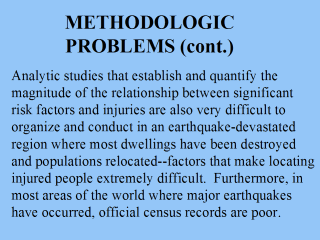 |
Even when good
census data are available, as in California, other factors such as the
proportion of people commuting to and from the affected area may greatly
affect the size of the population present at the actual time of the
earthquake. Thus, even estimating the population at risk may be difficult,
let alone selecting appropriate control subjects (133). As a result,
almost all of the published epidemiologic studies on earthquake-related
injuries are descriptive rather than the analytic studies necessary to test
hypotheses that particular types of exposures or hazards (e.g., collapsing
buildings) are associated with injuries. |
